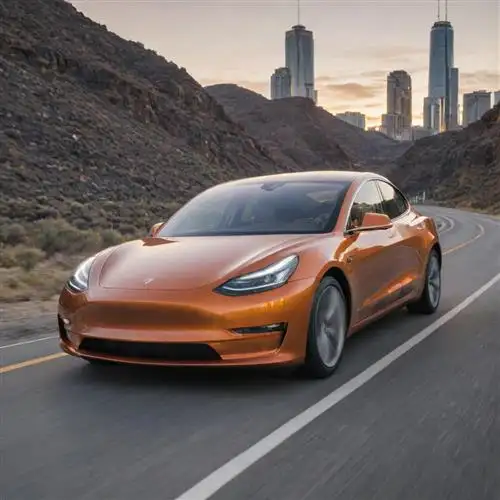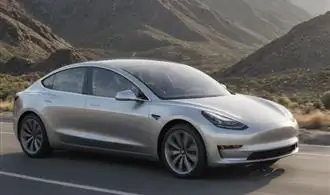
Optimizing Battery Management
Optimizing Battery Management for the Tesla Model 3 is crucial to maximizing the vehicle's efficiency and getting the most out of its impressive range. One of the key factors that determines the Tesla Model 3's efficiency is its battery management system. This sophisticated system manages the charging, discharging, and thermal regulation of the battery pack to ensure optimal performance and longevity.
One important aspect of battery management is the charging process. The Tesla Model 3's battery can be charged using a variety of methods, from standard household outlets to high-powered Tesla Superchargers. However, the way you charge your vehicle can have a significant impact on its efficiency. For example, using a Supercharger can recharge the battery more quickly, but it can also generate more heat, which can lead to faster battery degradation over time. Conversely, charging at home using a Level 2 charger can be gentler on the battery and help preserve its capacity for longer.
Another key factor in optimizing battery management is the way you drive your Tesla Model 3. Aggressive acceleration and high-speed driving can put a significant strain on the battery, leading to faster energy consumption and reduced range. By driving more conservatively, using features like Regenerative Braking, and minimizing the use of energy-intensive features like the climate control system, you can significantly improve the efficiency of your Tesla Model 3.
It's also important to consider the impact of environmental factors on the Tesla Model 3's battery management. Temperature, for example, can have a significant effect on the battery's performance and longevity. In hot climates, the battery's cooling system may need to work harder to maintain optimal temperatures, which can lead to faster battery degradation. Conversely, in cold climates, the battery may need to work harder to generate the necessary power, which can also impact efficiency.
- Prioritize charging at home using a Level 2 charger whenever possible, as this is gentler on the battery.
- Avoid using Superchargers for routine charging, as the high-powered charging can generate more heat and lead to faster battery degradation.
- Drive conservatively, with smooth acceleration and braking, to minimize the strain on the battery.
- Minimize the use of energy-intensive features like climate control when possible.
- Monitor the battery's health and performance over time, and consider adjusting your charging and driving habits accordingly.
Aerodynamic Design and its Impact
The Tesla Model 3's aerodynamic design is a crucial component that contributes to its impressive efficiency. The car's sleek and streamlined shape helps it slice through the air with minimal resistance, allowing it to maximize its range and minimize energy consumption. Understanding the intricacies of this design aspect can provide valuable insights for Tesla owners and enthusiasts alike.
One of the key features of the Model 3's aerodynamic design is its low drag coefficient. The drag coefficient, denoted as Cd, is a measure of how much an object's shape resists the flow of air around it. The lower the Cd, the more efficient the vehicle is in terms of energy usage. The Tesla Model 3 has a Cd of just 0.23, which is exceptionally low for a production vehicle. This sleek design helps the car slice through the air with ease, reducing the amount of energy required to maintain high speeds and enabling the vehicle to travel further on a single charge.
The Model 3's aerodynamic design is the result of extensive wind tunnel testing and computational fluid dynamics (CFD) simulations. Tesla's engineers have meticulously fine-tuned the car's shape, including the front fascia, side mirrors, and underbody, to minimize air resistance and turbulence. For example, the car's flush-mounted door handles and retractable side mirrors contribute to its streamlined appearance and reduce drag.
Another key aspect of the Model 3's aerodynamic design is its active grille shutters. These shutters, located in the front of the car, automatically open and close based on the vehicle's speed and cooling requirements. When the shutters are closed, they create a smooth, uninterrupted airflow over the front of the car, reducing drag and improving efficiency. This feature is particularly beneficial at high speeds, where air resistance becomes a significant factor in energy consumption.
The Model 3's underbody design also plays a crucial role in its aerodynamic performance. The car's flat underbody, along with strategically placed aero panels and diffusers, help to guide the airflow smoothly under the vehicle. This not only reduces drag but also enhances the car's stability and handling at high speeds.
In addition to the car's physical design, Tesla's software also plays a role in optimizing the Model 3's efficiency. The car's regenerative braking system, for example, captures the energy generated during deceleration and stores it in the battery, reducing the amount of energy required from the electric motors. This feature, combined with the car's aerodynamic design, helps to maximize the Model 3's overall efficiency and range.
Regenerative Braking Mastery
Unleashing the Power of Regenerative Braking in the Tesla Model 3: A Deep Dive into Efficiency and Performance. Regenerative braking is a game-changer in the world of electric vehicles, and the Tesla Model 3 is a prime example of this cutting-edge technology at work. As a Tesla Model 3 owner, understanding the intricacies of regenerative braking can not only enhance your driving experience but also unlock remarkable improvements in efficiency and range.
The key to mastering regenerative braking in the Tesla Model 3 lies in recognizing its unique characteristics and learning to harness them to your advantage. First and foremost, it's crucial to understand the underlying principles of regenerative braking. When you apply the brakes in a traditional gasoline-powered vehicle, the energy generated from the friction is simply converted into heat and dissipated. In contrast, the Tesla Model 3's regenerative braking system captures this kinetic energy and converts it back into electrical energy, which is then stored in the battery for later use.
This process not only enhances the overall efficiency of the vehicle but also extends the range you can achieve on a single charge. By learning to modulate the regenerative braking system and anticipate your braking needs, you can maximize the amount of energy being captured and reduce the strain on the mechanical brakes. This is particularly beneficial in stop-and-go traffic or when navigating hilly terrain, where the regenerative braking system can significantly contribute to your overall efficiency.
Another crucial aspect of mastering regenerative braking in the Tesla Model 3 is understanding the different braking modes and how to optimize them for your driving conditions. The Tesla Model 3 offers multiple regenerative braking settings, ranging from "Standard" to "Low" and "Creep". By experimenting with these settings and observing how they impact your driving experience and efficiency, you can find the sweet spot that best suits your personal preferences and driving style.
Additionally, developing a keen sense of when to apply the regenerative braking system can have a profound impact on your overall efficiency. Learning to anticipate upcoming stops, hills, or declines can allow you to maximize the energy capture and minimize the need for mechanical braking, further enhancing your Tesla Model 3's range and performance.
Driving Techniques for Maximum Efficiency
Maximizing the efficiency of your Tesla Model 3 goes beyond the car's impressive engineering. By adopting specific driving techniques, you can significantly improve your vehicle's energy consumption and range. Here are some insights that I wish I had known sooner:
Accelerate Gently: The Tesla Model 3's instant torque and powerful acceleration can be tempting, but rapid acceleration can significantly impact your efficiency. Instead, focus on gentle, gradual acceleration. This not only preserves battery life but also allows you to take advantage of the car's regenerative braking system more effectively.
Maintain Consistent Speed: Rapid changes in speed, such as sudden braking and acceleration, can lead to increased energy usage. Aim to maintain a steady, consistent speed whenever possible. This can be achieved by utilizing the car's cruise control or Autopilot features, which can help you maintain a constant velocity and optimize efficiency.
Leverage Regenerative Braking: The Tesla Model 3's regenerative braking system is a powerful tool for maximizing efficiency. When decelerating or braking, the system converts the car's kinetic energy into electrical energy, which is then stored in the battery. By anticipating stops and using the regenerative braking system, you can recapture a significant amount of energy that would otherwise be lost.
Plan Your Route: Consider the impact of your route on efficiency. Avoid steep hills, frequent stops, and heavy traffic whenever possible, as these conditions can significantly reduce your Tesla's range. Instead, opt for routes with gentle inclines, fewer traffic lights, and less congestion to maximize your efficiency.
Monitor Energy Usage: Familiarize yourself with the Tesla Model 3's energy consumption data displayed on the dashboard or in the mobile app. Understanding your real-time energy usage and efficiency can help you make informed decisions about your driving style and route planning.
Optimize Climate Control: The Tesla Model 3's climate control system can have a significant impact on energy consumption. Adjust the temperature and fan settings to find the most efficient balance between comfort and energy usage. Additionally, consider using the "Cabin Overheat Protection" feature to minimize the need for climate control when the car is parked.
Optimizing Charging Strategies
Owning a Tesla Model 3 comes with incredible benefits, but understanding the intricacies of charging can significantly enhance your driving experience and maximize the efficiency of your electric vehicle. One of the most critical aspects to consider is your charging strategy, as it can impact your battery health, charging times, and overall energy consumption.
First and foremost, it's essential to understand the different charging levels available for your Tesla Model 3. Level 1 charging, which utilizes a standard household outlet, is the slowest option but can be convenient for overnight charging. Level 2 charging, on the other hand, can significantly reduce your charging times and is the preferred method for most Tesla owners. By installing a Level 2 charging station at your home or workplace, you can enjoy faster charging speeds and more efficient energy usage.
When it comes to optimizing your charging strategy, the key is to strike a balance between convenience, cost, and battery health. One effective approach is to use your Tesla's scheduled charging feature, which allows you to set specific charging times and adjust the charge rate. By scheduling your charging during off-peak hours, you can take advantage of lower electricity rates and reduce the strain on the grid.
Additionally, it's important to pay attention to your battery's state of charge (SOC) and avoid repeatedly charging your Tesla Model 3 from a low SOC to a high SOC. Experts recommend keeping your battery within the 20-80% range whenever possible, as this can help preserve the long-term health of your battery and maximize its lifespan.
Another valuable strategy is to utilize Tesla's Supercharger network, but with a mindful approach. While Superchargers provide incredibly fast charging, they should be used primarily for long-distance travel or in emergency situations. Relying too heavily on Superchargers can put stress on your battery and potentially reduce its overall efficiency.
- Monitor your Tesla's energy usage and charging patterns to identify opportunities for improvement.
- Adjust your driving habits, such as reducing aggressive acceleration and maintaining a consistent speed, to improve your overall energy efficiency.
- Investigate local utility programs or incentives that may offer discounted electricity rates for electric vehicle owners, allowing you to save on charging costs.
- Stay up-to-date with the latest information and updates from Tesla, as the company is constantly improving its charging technology and software features.
















